![]()
![]()
![]()
Use LEFT and RIGHT arrow keys to navigate between flashcards;
Use UP and DOWN arrow keys to flip the card;
H to show hint;
A reads text to speech;
104 Cards in this Set
- Front
- Back
|
Process by which the eye adjusts for near distance by changing the curvature of the lensto focus a clear image on the retina
|
Accomidation
|
|
|
Space in the eye bordered anteriorly by the cornea and posteriorly by the iris and pupil
|
Anterior Chamber
|
|
|
Absence of a natural lens
|
Aphakia
|
|
|
Refractive error in which light rays are spread over a diffuse area rather than sharply focused on the retina, a condition caused by differences in the curvature of the cornea and lens.
|
Astigmatism
|
|
|
Inability to see, ususally defined as corrected visual acuity of 20/400 or less, a visual field of no more than 20* in the better eye
|
Blindness
|
|
|
Edema of the conjunctiva
|
Chemosis
|
|
|
Retinal photoreceptor cells essential for visual acuity and color discrimination
|
Cones
|
|
|
Seeing one object as two; or double vision
|
Diplopia
|
|
|
Absence of refractive error
|
Emmetropia
|
|
|
Complete removal of the eyeball and part of the optic nerve
|
Ennucleation
|
|
|
Removal of the intraocular contents through a corneal or scleral incision, the optic nerve, sclera, extraocular muscles, and sometimes the cornea are left intact.
|
Evisceration
|
|
|
Surgical removal of the entire contents of the orbit, including the eyeball and lids
|
Exenteration
|
|
|
"Red eye" resulting from dilation of the vasculature of the conjunctiva
|
Hyperemia
|
|
|
Farsightedness, a refractive error in which the focus of light rays from a distant object is behind the retina
|
Hyperopia
|
|
|
Blood in the anterior chanber
|
Hypema
|
|
|
Collection of inflammatory cells that has the appearance of a pale layer in the inferior anterior chamber of the eye
|
Hypopyon
|
|
|
Conjestion of blood vessels
|
Injection
|
|
|
Cone shaped deformity of the cornea
|
Keratoconus
|
|
|
Corneal edema with painful blisters in the epithelium doe to excess corneal hydration
|
Keratopathy, bullous
|
|
|
Junction of the cornea and sclera
|
Limbus
|
|
|
Medications that cause pupillary constriction
|
Miotics
|
|
|
Medications that cause pupillary dilation
|
Mydriatics
|
|
|
Nearsightedness, a refractive error in which the focus of light rays from a distant object is in front of the retina
|
Myopia
|
|
|
Growth of abnormal new blood vessels
|
Neovascularization
|
|
|
Swelling of the optic disk due to IOP
|
Papilledema
|
|
|
Ocular pain on exposure to light
|
Photophobia
|
|
|
Space between the iris and vitreous
|
Posterior chamber
|
|
|
Downward displacement of the eyeball resulting from and inflammatory condition of the orbit or a mass with the orbital cavity
|
Proptosis
|
|
|
Drooping of an eyelid
|
Ptosis
|
|
|
Determination of the refractive errors of the eye and correction by lenses
|
Refraction
|
|
|
Retinal photoreceptor cells essential for bright and dim light
|
Rods
|
|
|
Blind or partially blind areas in the visual field.
|
Scotomas
|
|
|
A condition in which there is deviation from perfect ocular alignment
|
Strabismus
|
|
|
An inflammatory condition created in the fellow eye by the affected eye (without useful vision); the condition may become chronic and result in blindness (of the fellow eye)
|
Sympathetic Ophthalmia
|
|
|
A bilateral chronic follicular conjunctivitis of childhood that leads to blindness during adulthood if left untreated
|
Trachmoa
|
|
|
Abciximab
|
Monoclonal antibody to fibrin receptor (glycoprotein IIb/IIIa) on platelets
Used to prevent clotting after coronary angioplasty and in acute coronary syndrome also eptifibatide and tirofiban |
|
|
OD
|
Right eye
|
|
|
OS (sinister)
|
Left Eye
|
|
|
OU
|
Both Eyes
|
|
|
This is used to test peripheral vision
|
Perimetry Testing
|
|
|
Visulaizes the angle of the anterior chamber
|
Gonioscopy
|
|
|
Handheld tool to assess structures of the eye
|
Direct Ophthalmoscopy
|
|
|
Measures IOP
|
Tonometry
|
|
|
A binocular microscope mounted on a table which magnifies 10 to 40 times the real image
|
Slit lamp exam
|
|
|
Can be used to identify orbital tumors, retinal detachment, and changes in tissue composition.
|
Ultra sonography
|
|
|
Is used to evaluate abnormalities in the chorodial vasculature, conditions often seen in macular degeneration
|
Indocyanine Green Angiography
|
|
|
A screening test, such as the polychromatic plates can be used to assess this
|
Color vision testing
|
|
|
Age related changes of the eye are caused by
|
Loss of skin elasticity and orbital fat and decreased muscle tone
|
|
|
This test is used to identify macular problems
|
Amsler Grid
|
|
|
Normal vision
|
Emmetropia
|
|
|
A group of ocular conditions in which damage to the optic nerve is related to IOP caused by congestion of the aqueus humor
|
Glaucoma
|
|
|
The leading cause of blindness in the U.S, incidence increases with age
|
Glaucoma
|
|
|
A normal intraocular pressure is
|
between 10 and 21 mmHg
|
|
|
Production and drainage are not in balance.
When aqueus outflow is blocked pressure builds up in the eye Increased IOP causes irreversible mechanical and or ischemic damage |
Glaucoma
|
|
|
The silent theif, renders pt unaware until there is significant vision loss, including peripheral vision loss, blurring, halos, difficulty focusing and difficulty adjusting eyes to low lighting. May experience aching or discomfort around the eye or a headache
|
Glaucoma
|
|
|
Diagnostic test for Glaucoma
|
Tonometry to assess IOP
Gonioscopy to assess the anterior chamber Perimetry to assess vision loss |
|
|
Goals in treating glaucoma
|
Prevent further optic nerve damage
Maintain IOP within a range unlikely to cause damage Pharmacologic therapy Surgery |
|
|
Surgeries for glaucoma
|
Laser Trabeculoplasty
Laser Iridotomy Filtering procedures Trabeculectomy Drainage implants or shunts |
|
|
Nursing Mgmt for Glaucoma
|
Focus on maintaining therapeutic regimin for lifeling control
Emphasize the need for adherence to therapy and continued care to prevent further vision loss Provide education regarding use and effects of meds Meds may cause SE so stress the need for compliance Provide support and interventions to aid pt in adjusting to vision loss |
|
|
This is an opacity of the lens
Increased incidence with aging by age 80 more than 1/2 of all americans have A leading cause of disability in U.S. |
Cataracts
|
|
|
Azithromycin
|
Antibiotic
similar to erythromycin, but greater activity versus chlamydia, H influenzae, and streptococci; long half−life due to tissue accumulation. renal elimination. Tox: GI distress, but no inhibition of drug metabolism Clarithromycin is similar but has a shorter half-life and inhibits drug metabolism |
|
|
What test is used to est. the degree of cataract formation
|
Slit lamp biomicroscopic exam
|
|
|
Intracapsular extraction (ICCE)
Extracapsular extraction (ECCE) Phacoemulsifaction Lens replacement |
Are all types of cataract surgeries
|
|
|
Nursing mgmt pre op cataract surgery
|
Dilating eye drops or other meds
Provide verbal and written instructions Instruct to call dr immediately if: Vision changes, flashing lights appear, redness or swelling or pain increases, type and amt of drainage increases, significant pain not relieved by tylenol |
|
|
Treatment for corneal disorders
|
Phototherapeutic keratectomy
Keratoplasty Donor tissue Need for f/u and support Potential graft failure, teach s/s |
|
|
These are elective procedures to recontour corneal tissue and correct refractive errors
Pts need counseling regarding potential benefits, risks, and complications |
Refractive Surgery
|
|
|
List the different types of retinal disorders
|
Detachment
Vascular disorders Central, Branch, and central retinal vein occlusion Macular degeneration |
|
|
Seperation of the sensory retina and the retinal pigment epithelium
|
Retinal Detachment
|
|
|
S/S of retinal detachment
|
Shade/curtain across field of vision
Bright flashing lights Sudden onset of floaters |
|
|
Diagnostic tests for retinal detachment
|
Assess visual acuity, retina by ophthalmoscope
Slit lamp stereo fundus photography Fluroescein andiography, tomography, and ultrasound may also be used |
|
|
Surgical treatment for retinal detachment
|
Scleral buckle
Pars plana vitrectomy Pneumatic retinoplasty |
|
|
This type of surgery involves removal of the vitreous, locating the incisions at the pars plana
|
Pars plana vitrectomy
|
|
|
This surgery injects a gas bubble, liquid, or oil and it is used to flatten the sensory retina against the RPE. Post op positioning is critical
|
Pneumatic retinoplexy
|
|
|
Mursing management for post op retinal surgery
|
Pt teaching: s/s of complications, esp increased IOP and infection
Promote comfort Pt may need to lie in special position with pneumatic retinoplexy |
|
|
Loss of vision can occur from these occlusions
|
Retinal vein or Artery occlusion
|
|
|
Retinal vein or Artery occlusion may result from:
|
Atherosclerosis
Cardiac valvular disease venous stasis HTN Increased blood viscosity |
|
|
Associated risk factors for Retinal vein or Artery occlusion
|
DM
glaucoma Aging |
|
|
In this condition pts may report decreased visual acuity or sudden loss of vision
|
Retinal vein or Artery occlusion
|
|
|
This is the most common cause of vision loss in persons older than age 60
|
Macular degeneration
|
|
|
This type of macular degeneration involves the slow breakdown of the layers of the retina with the appearance of drusen
|
Dry or non exudative
85-90% people have this type |
|
|
This type of macular degeneration my have an abrupt onset
Proliferation of abnormal blood vessels growing under the retinachoroidal revascularization (CNV) |
Wet type
|
|
|
This type of therapy slows the progression of Macular degeneration dye is injected into vessels, a laser then activates the dye shutting down the vessels without damaging the retina
|
Photodynamic therapy
|
|
|
After photodynamic therapy pt must avoid:
|
Exposure to sunlight or brightlight for 5 days after treatment, to avoid activation of dye in vessels near the surface of the skin
|
|
|
Nursing management for pts who have had photodynamic therapy
|
Pt teaching
Supportive care Safety promotion Recommendations include: Improving lighting magnification devices refer pt to vision ctr to improve/promote function |
|
|
Emergency treatment for eye trauma
|
Do not remove objects, protect using metal shield or cup
Flush chemical injuries |
|
|
This is classified by cause: bacterial, fungal, viral, parasitic, allergic or toxic
|
Conjunctivitis "Pink eye"
|
|
|
Ocular consequences of systemic disease are:
|
Diabetic retinopathy (leading cause of blindness in people age 20-74)
Complications assoc with AIDS Eye changes assoc with HTN |
|
|
Things to know about eye meds
|
Ability to absorb is limited
Barries to this are size of conjunctival sac, corneal membrane barrier, blood-ocular barrier, tearing, blinking and drainage. Topical are used most they are least invasive, fewer SE, and can self administer |
|
|
These dilate the eye
|
Mydriatics
|
|
|
These paralyze the eye
|
cycloplegics
|
|
|
These eye meds are contraindicated with narrow angles or shallow anterior chambers and for pts on MAOI's or tricyclic antidepressants
May cause CNS symptoms, increased BP (children/elderly) |
Mydriatics and cycloplegics
|
|
|
These meds increase aqueous outflow or decrease aqeous production.
May constrict pupil and affect the ability to focus the lens, may also produce systemic effects |
Medications used for Glaucoma
|
|
|
Side effects of anti-inflammatory, corticosteroid suspensions:
|
Glaucoma
Cataracts increased risk for infection To avoid NSAID therapy may be used as an alternate |
|
|
Visual impairment that requires devices and stratigies in addition to corrective lenses
Best corrected visual acuity (BCVA) of 20/70 to 20/200 |
Low Visionq
|
|
|
BCVA of 20/400 to no light perception
Legal blindness is BCVA that does not exceed 20/200 in better eye or widest field of vision is 20* or less |
Blindness
|
|
|
Impaired vision is often accompanied by:
|
Functional impairment
|
|
|
Assessment of low vision includes:
|
Hx
Exam of distance and near visual acuity, visual field, contrast sensitivity, glare, color, perception and refraction Special charts used Functional ability, coping and adaption in emotional, physical and social areas |
|
|
Nursing mgmt for low vision
|
Support coping stratigies, greif process and acceptance of visual loss
Stratigies for adaptation of environment, clock method for tray. Communication stratigies, collaborate with vision specialist, OT, braille or other methods for reading Service animals |
|
|
Common causes of blindness and visual impairment among adults 40 or older include:
|
Diabetic retinopathy
Glaucoma Macular degeneration |
|
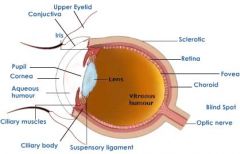
|

|
|
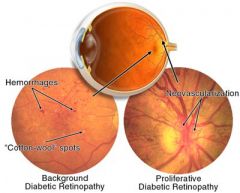
|

|
|
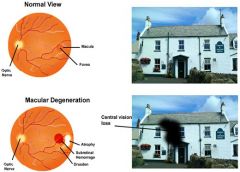
|

|
|
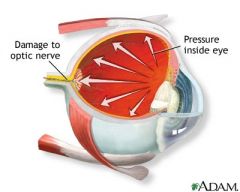
Glaucoma
|

Glaucoma
|
|
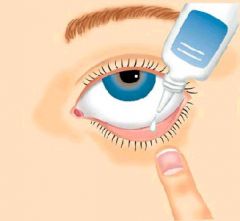
How to correctly instill eye drops
|

|

